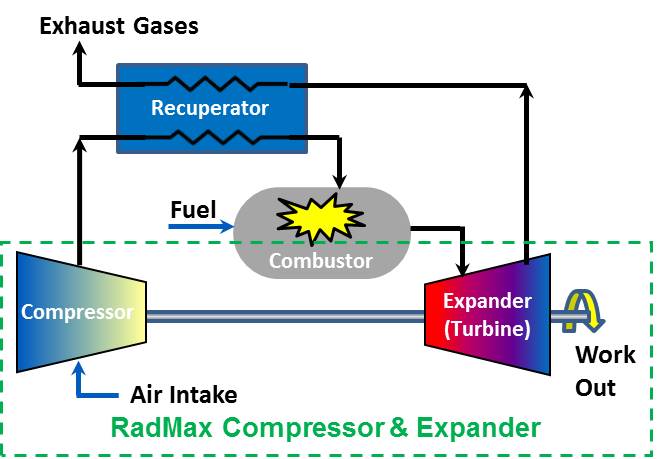Turbine Engine
Warning: Undefined variable $scroller in /var/general-sites/radmaxtech.com/www/view/template/main/body.php on line 10
Warning: Undefined variable $booth in /var/general-sites/radmaxtech.com/www/view/template/main/body.php on line 11
Turbine Engine
Internal and external combustion engines are the two basic types of prime movers that burn fuel to produce power. Examples of internal combustion engines are spark-ignited gasoline (Otto Cycle) and compression-ignition engines (Diesel Cycle). Examples of external combustion engines are the steam engine (Rankine Cycle), hot air engine (Sterling), and the gas turbine engine (Brayton Cycle).
All of these cycles have particular operating and physical characteristics and different economic considerations that lend to their use for specific applications. The following table summarizes a comparison of these factors.
Engine Types Comparison
|
Engine Type |
Efficiency |
Emissions |
Cost |
Weight |
|
Spark Ignition (Otto) |
Poor |
Poor |
Good |
Good |
|---|---|---|---|---|
|
Compression Ignition (Diesel) |
Good |
Poor |
Fair |
Fair |
|
Steam (Rankin) |
Good |
Poor - Good |
Poor - Good |
Poor |
|
Hot Air (Sterling) |
Good |
Poor |
Poor |
Poor |
|
Gas Turbine (Brayton) |
Poor |
Good |
Poor |
Good |
Long service life, low power-to-weight ratio, and increasing environmental concerns and regulations are prompting a second look at the viability of gas turbine engines for more mainstream applications. A gas turbine engine’s optimized combustion produces fewer total emissions than internal-combustion engines. However, their lower operating efficiencies and higher operating and capital costs are impediments to their increased use.
The RadMax Turbine Engine looks to improve on existing gas turbine efficiency and cost deficiencies by incorporating RadMax technology’s higher efficiency and lower cost positive-displacement compressor and gas expander.
RadMax Positive Displacement Turbine Engine
The RadMax turbine engine features a high efficiency RadMax positive-displacement compressor and gas expander coupled with an external combustor and a recuperator (exhaust heat exchanger). The combination of these devices provides significantly improved fuel and energy extraction efficiency over conventional gas turbine engines.


The resulting lower exhaust temperature from the use of a higher efficiency compressor and expander also has the advantage of decreased emissions compared to conventional gas turbine engines. Additionally, the integration of the compressor and expander in one unit, the use of large area intake and exhaust ports instead of valves, and the high displacement per device size, all greatly reduce heat transfer losses.
Capable of burning almost any type of gaseous or liquid fuel, the RadMax turbine engine is characterized by:
- Continuously optimized combustion resulting in lower emissions, higher engine efficiency, and better fuel economy (est. 50+% brake efficiency)
- Lower speed than conventional gas turbines with higher torque
- High turndown ratio
- High horsepower-to-weight ratio
- Smooth running
- Low noise
- Lower cost to produce, operate and maintain
- Easily scalable from 20 Hp and above
Because of its multi-fuel, high fuel efficiency, compact size and clean burning capabilities, the RadMax turbine engine is well suited for power generation and hybrid vehicle applications.
RadMax Turbine Engine Operation
In the RadMax turbine engine, as the compressor and expander vanes move axially, driven by the rotor face, the pressure in each chamber changes when the adjacent vanes extend or retract. During rotor revolution, the ends of the vanes follow a path that approximates a sinusoidal wave. This path is uniquely designed so that during each revolution of the rotor the chambers’ volumes alternately expand and contract. The process is repeated in each of the turbine sections, in each chamber, and on each side of the rotor. Compressed air from the compressor sections is ported to the combustor, and hot, high-pressure gas from the combustor is routed to the input of the gas expander sections.
The RadMax turbine engine rotor spins continuously in one direction rather than violently changing directions as with pistons in a reciprocating engine. Because the upper and lower faces of the rotor are 90-degrees out of phase, the RadMax turbine engine is always balanced and exhibits minimal vibration.

RadMax Turbine Combined Configuration
The RadMax turbine design is a combination of four distinct sections, two on each cam. This unique design allows for each of these sections to potentially be configured with different compression or expansion ratios. For certain applications, it would be possible to configure two or three of the sections as expanders and one or two section as a compressor, thus eliminating the need for separate compressor and expander cams.
This is illustrated in this graphic where the green center represents the rotor in an “unwrapped” condition. The vertical yellow bars are the sliding vanes separating each chamber, and the black sinusoidal curves represent the cam surfaces. As the rotor turns, the segments formed by the rotor, cams and vanes increase or decrease in volume, thus functioning as turbines or compressors.
In this example three sections of the RadMax engine are configured as expanders. The fourth section is configured as a compressor. Each of the expansion sections receives high-pressure gases from the external combustor and produces rotation energy. The compressor section takes in ambient air and provides compressed air to the combustor.